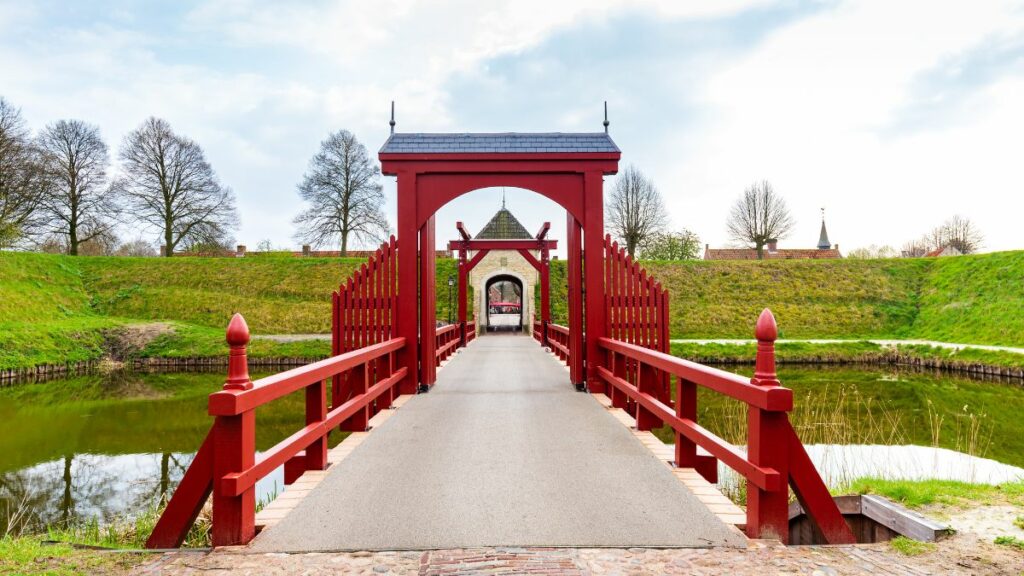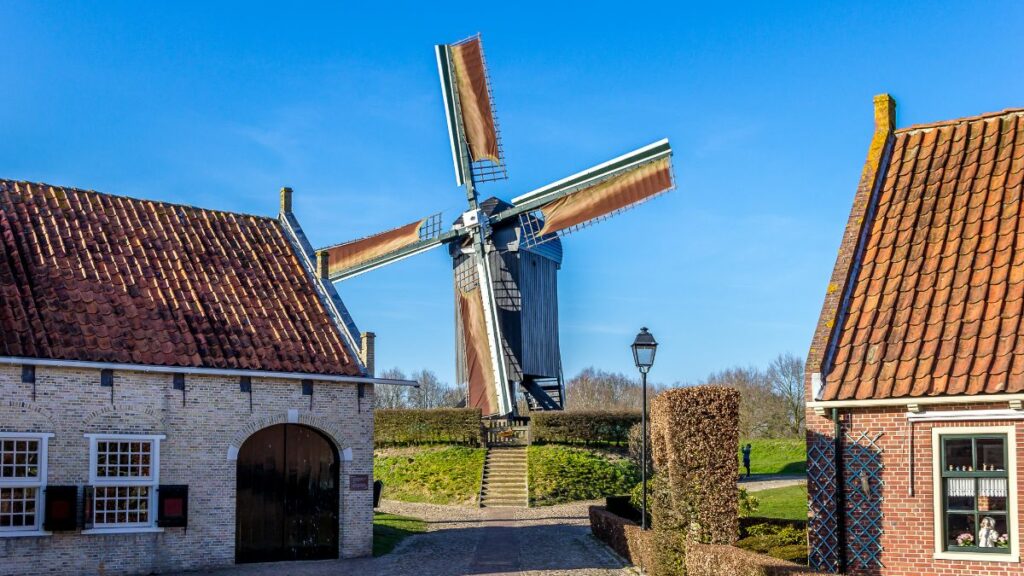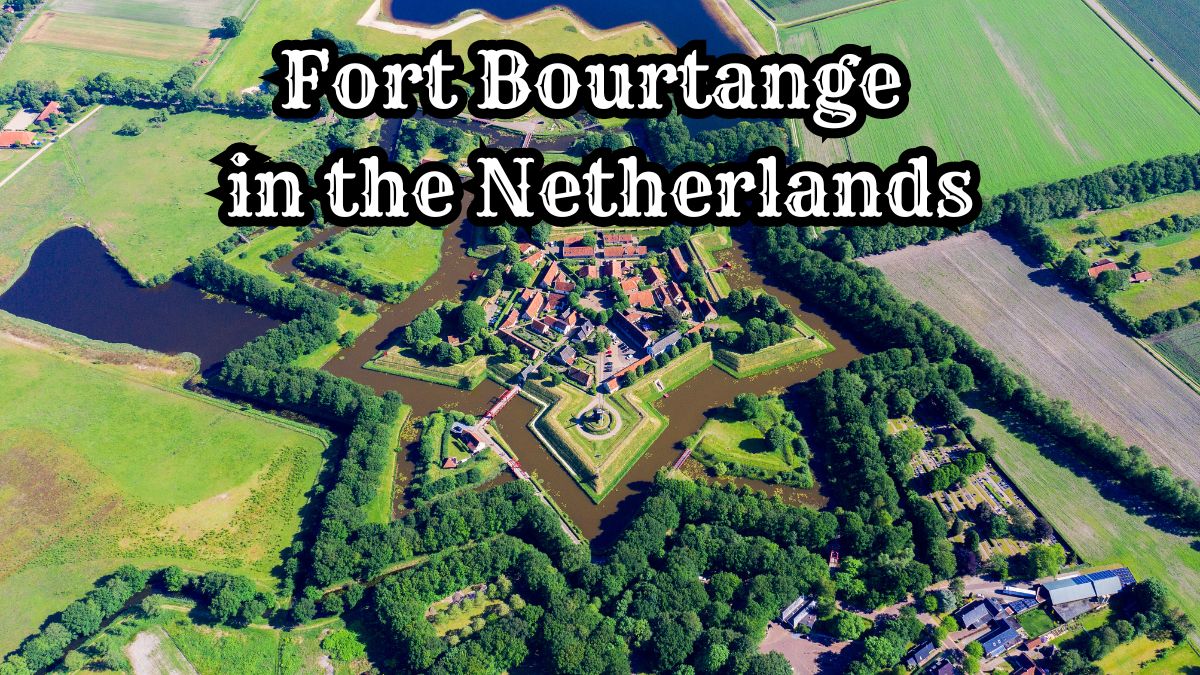Fort Bourtange is a star fort located in the Northern Netherlands, in the province of Groningen, on the German border.
Built-in 1593 during the Dutch Revolt, this fortification was strategically constructed to control the only road between Germany and the city of Groningen, which the Spaniards controlled at that time.
The fort’s unique layout, characterized by its geometric shape and surrounding moats, was based on the principles of Italian architect Francesco di Giorgio Martini.
Over the centuries, Fort Bourtange served its military purpose until it was decommissioned in 1851.
The fort then transformed into a peaceful village, and the once strategic defense point gradually faded into obscurity until the 20th century.
A major restoration project began in the 1960s, aiming to restore the fort to its 18th-century state.
This meticulous work resulted in an open-air museum that offers a window into the past, allowing visitors to experience history firsthand.
Today, Fort Bourtange stands as a well-preserved example of Dutch military architecture.
Visitors can explore the ramparts, barracks, and armories and immerse themselves in the life of a garrison town.
The site is a popular tourist attraction and an educational resource, providing insights into the Netherlands’ military and cultural heritage.
History of Fort Bourtange

Fort Bourtange stands as a unique star fort, built in the late 1500s during the Dutch Revolt for strategic control of the only road between Germany and Groningen, which was under Spanish control.
Origin and Purpose
Constructed on the orders of William of Orange in 1593, Fort Bourtange was built to control the road leading to the city of Groningen. It disrupted the enemy’s supply lines and aided the Dutch efforts during the Eighty Years’ War.
The strategic location was chosen to ensure Dutch forces could launch successful offensives against the Spanish.
Purpose of the Fort:
- Control passage: Secure the only road from Germany to Groningen.
- Military campaigns: Support Dutch efforts against Spanish forces.
Sieges and Military History
Throughout its operational history, Fort Bourtange saw multiple sieges.
Its most notable military engagement was the final battle in 1672 against the German army of the Prince-Bishopric of Münster.
Captain Protts led the defense against the attacks, and the fort never succumbed to the siege, maintaining control over the passage to Groningen.
Key Sieges:
- 1672 siege: Prince-Bishopric of Münster’s unsuccessful siege.
- No losses: The Fort remained impenetrable throughout its military history.
Transformation and Restoration
After losing its strategic relevance in the 19th century, Fort Bourtange transitioned into a village community by 1851.
However, in the 20th century, efforts were made to restore the fort to its 18th-century state.
Nowadays, it is a historical site where visitors can experience historical reenactments, bringing to life the era of the Eighty Years’ War.
Restoration Efforts:
- 20th-century project: Restored to 1750s appearance.
- Cultural hub: Venue for historical reenactments and educational purposes.
Architectural Features

Fort Bourtange is a prime example of a star-shaped fort, notable for its strategic architectural elements and vital for its defensive capabilities.
Design and Layout
Fort Bourtange is distinguished by a striking star fort design, characteristic of many late Renaissance forts.
The fort’s layout includes five triangular bastions arranged to provide overlapping fields of fire.
A main cobblestone road leads directly to the central market square, Terra Mora, and guides visitors to the fort.
The fort’s layout was meticulously planned to facilitate defense and the everyday functions of military life.
- Cobblestone Streets: These were functional and contributed to the fort’s allure.
- Central Market Square (Terra Mora): Served as the hub for the fort’s activities.
Defensive Structures
Fort Bourtange’s defensive network was engineered to provide the best defense against attackers and to enable horizontal artillery fire.
Its defensive and fort walls were integral to the fort’s ability to withstand sieges.
- Defensive Walls: Thick earthen walls reinforced with stone.
- Network of Canals: Served as obstacles for enemies and a source of transportation within the fort’s vicinity.
- Inner Fortification: Ensured additional protection and strategic advantage for the troops there.
Throughout the years, particularly between 1740 and 1750, the fort witnessed enhancements to its defensive structures to ensure it adapted to advancements in siege tactics.
Fort Bourtange later underwent reconstruction to restore its appearance to its 1750 state, and it is now preserved as a historical and cultural site.
Exploring More: Historic Forts in Canada: Exploring Strongholds of the North
Cultural Significance and Today’s Bourtange

Fort Bourtange serves as a historical emblem in the Netherlands. Its old military barracks house museums and exhibits while maintaining its heritage as a modern-day village.
Museum and Education
Fort Bourtange is home to the Historical Museum, which offers visitors a closer look at the fort’s past and the surrounding region’s history.
The Main Exhibit provides an in-depth view of the area’s military history and geopolitical significance over the centuries.
Educational programs are frequently organized for cultural trips, engaging visitors in the richness of Bourtange’s history.
- Museum Tickets can be purchased at the Information Centre.
- Educational resources accommodate various age groups, enhancing cultural understanding through history.
Modern-Day Village
Today, the Village of Bourtange reflects a slice of history preserved in time. As a quaint village with quaint houses, it attracts those interested in experiencing life in an old town setting.
The restored Old Military Barracks are complemented by the small church, contributing to the region’s charm.
- The local government manages this well-preserved historical site, integrating tourism with local life.
- Public Transport services are available, facilitating access to this excellent place for visitors and locals alike.
- Maintaining the area’s natural beauty remains a priority for both conservation and enjoyment.

Cory is a website owner and content creator who enjoys fishing, history, coin collecting, and sports, among other hobbies. He is a husband and father of four.
Romans 15:4 For whatever was written in former days was written for our instruction, that through endurance and through the encouragement of the Scriptures we might have hope.

